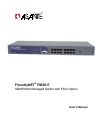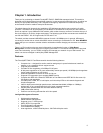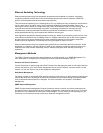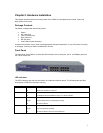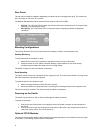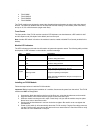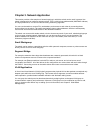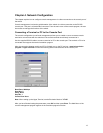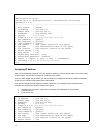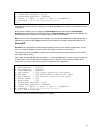6
Ethernet Switching Technology
Ethernet switching technology has dramatically boosted the total bandwidth of a network, eliminating
congestion problems inherent with Carrier Sense Multiple Access with Collision Detection (CSMA/CD)
protocol, and has greatly reduced unnecessary transmissions.
This revolutionized networking in the following ways: First, by allowing two-way, simultaneous transmissions
over the same port (Full-duplex mode), which essentially doubled the network bandwidth; Second, by
reducing the collision domain to a single switch-port, which eliminated the need for carrier sensing; Third, by
using the store-and-forward technology’s approach of inspecting each packet to intercept corrupt or
redundant data, switching eliminated unnecessary transmission that slows the network; Finally, by
employing address learning, which replaced the inefficient receiving port.
Auto-negotiation regulates the speed and duplex of each port, based on the capability of both devices. Flow-
control allows transmission from a 100Mbps node to a 10Mbps node without loss of data. Auto-negotiation
and flow-control may require disablement for some networking operations involving legacy equipment.
Disabling the auto-negotiation is accomplished by fixing the speed or duplex of a port.
Ethernet switching technology has supplied higher performance at costs lower than other solutions. Wider
bandwidth, no congestion, and the reduction in traffic is why switching is replacing expensive routers and
inefficient hubs as the ultimate networking solution. Switching brought a whole new way of thinking to
networking.
Management Methods
The FM2017 supports configuration and management via a Web-browser or via SNMP Management. For
more information on configuring and managing your switch, please see Chapters 4 and 5.
Console and Telnet Connection
Console Connection is done through the RS-232 Console Port. Managing the switch in this method requires
a direct connection to a PC, while Telnet management is done over the network. Once the switch is on the
network, you can use Telnet to Log in and change the configuration.
Web-Based Management
The switch provides an embedded HTML web site residing in flash memory. It offers advanced management
features and allow users to manage the switch from anywhere on the network through a standard browser
such as Microsoft Internet Explorer or Navigator. For more information, see Chapter 5. Web-Based
Management.
SNMP Network Management
SNMP (Simple Network Management Protocol) provides a means to monitor and control network devices
and report activity in each network device to manage configurations, performance, and security. This switch
provides up to 4 IP addresses for the access of trap managers. You can submit community strings on get-
community, set-community and trap-community to authorize management access.



